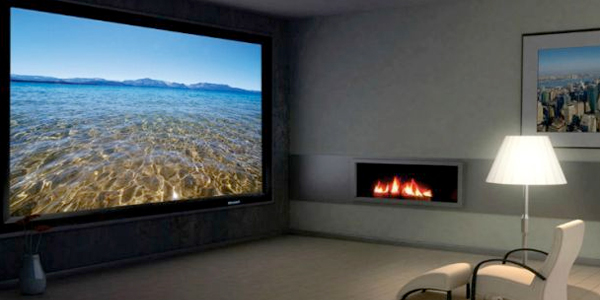Projectors vs. Flatscreens: What's the Difference?
by Scott Huffman

Projectors and flat screens both have their place in modern homes, but when is a projector the right choice for you?
Size
The most obvious reason to use a projector is when you need a really big screen! Displays are typically marketed in diagonal inches. While flat screens over 65" are uncommon and very expensive, two-piece projection systems are normally 80" and larger and more affordable.
Types
Two-piece projection video systems consist of a video projector and a screen. Projection systems can be front or rear projection. Most systems are front projection, where the projector is mounted in the room with the viewer. Rear projection systems consist of a glass screen with the projector mounted in a room behind the screen.
Environment
Rear projection systems do not have any special room requirements, and give the appearance of a large flat screen tv built into the wall. Front projection systems need a dimly lit room. Any ambient light shining on the screen takes away from the black levels and the picture appears less bright and less sharp. Special considerations should be taken when choosing light fixtures and draperies.
Picture Quality
Recently, we upgraded our showroom projector to a Sony with a contrast ratio of 60,000 to one. Many visitors have made the comment, "I didn't know projectors could look this good." In recent years, projectors have made leaps in technology to allow a superior picture, and at the same time have become more economical.
Comparison
One of my favorite demonstations in our showroom is to show a client that a 100" projection system is the exact same size as four 50" flat sceen televisions. At first, most would think that 100" is only twice as big as 50", but the diagonal measurement is a combination of the length and height. A fair comparison would require finding the surface area of a display by multiplying the width and height of the viewing area.
Screens
Fixed-screens are most common in home theater rooms, while some spaces require an electric retractile for hidden installations. The quality of the screen should be proportional to the quality of the projector. You can expect to spend between $600 and $2,000 for a decent quality 100" screen. Gain is an important aspect of the screen. A home theater designer should be able to recommend the correct gain, fabric, and mounting type.
Uses
One common question from clients is, "Can the projection system be used for anything other than movies?" Absolutely. Yes, a large screen projection system is the closest thing for movies to going to the cinema. And yes, video games, sporting events, and daily television viewing are all great when they are life-size.
Other Considerations
- Don't forget the screen. A projector is only "half the picture."
- Dim the lights.
- Projector's don't have tuners, so you must use a cable or satellite receiver for tv channels.
- Special consideration for mounts, cabling, and electrical outlets need to be considered and planned for before the project begins.